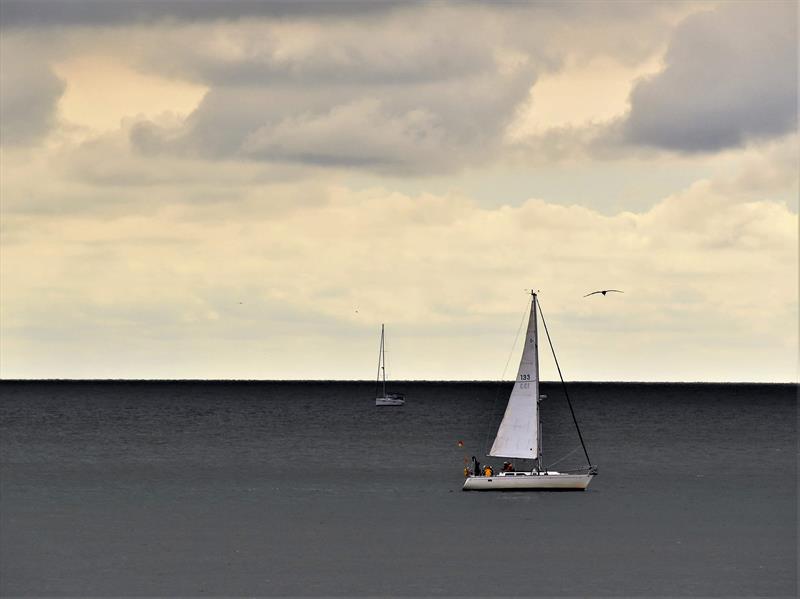
An interview with Duane Guidry about the 2019 Harvest Moon Regatta
by David Schmidt 8 Oct 2019 08:00 PDT
October 10-13, 2019

Racecourse action at the 2018 Harvest Moon Regatta © Harvest Moon Regatta/Lakewood Yacht Club
Yacht clubs play many important roles in American sailing including providing an institutional-level push to encourage members and local sailors to use and enjoy their boats more. This, in fact, was the rally cry that sounded in 1987 at the Lakewood Yacht Club, in Seabrook, Texas, beginning first with a rum-fueled conversation that-come the sober light of morning (and after many follow-up meetings)-still sounded like a grand idea involving October winds, great offshore conditions, and a chance to take the fleet out of sight of land for a final airing before the start of the northerlies that historically roil the Gulf of Mexico during winter months.
The result was the Harvest Moon Regatta (established 1987), a 150-mile offshore contest that begins off of Galveston, Texas, and takes the fleet on a tour of Gulf of Mexico buoys before finishing off of Port Aransas, Texas. The Harvest Moon Regatta is open to cruising boats, multihulls, PHRF handicap classes (which will be scored on a time-on-time basis), and the performance-orientated Bacardi Fleet (which will be scored on the ORC Club Offshore time-on-time scoring).
While the inaugural event attracted 17 competing boats, more recent years have seen fleets exceeding 260 boats. A glance at this year’s scratch sheet reveals boats ranging from go-fast monohulls like J/120s, J/109s and J/105s, to lickety-split F27 and F31 trimarans, to venerable cruisers such as a Morgan 46 and an Island Packet 38, to comfortable catamarans such as a Leopard 44 and a Maine Cat 38.
I checked in with Duane Guidry, regatta chair of the 2019 Harvest Moon Regatta (October 10-13), via email, to learn more about this now-classic Southern Coast fall challenge.
Can you explain the race’s culture to the uninitiated?
Harvest Moon Regatta is in its 33rd year as an offshore race with something for everyone, from a first-time offshore sailor to a world class offshore racer, topped off with a big Bacardi Rum party.
Can you describe the levels of competition that sailors can expect to find, once the starting guns begin sounding?
We have cruising sailors with no spinnaker who will fish as they sail, and we have serious racers with large spinnakers who will change sails multiple times through the night. The prestigious Bacardi Cup will go to a serious racer using the ORC handicapping system while the coveted Cameron Cannon will go to a cruising sailor.
Can you give us a 35,000’ overview of the racecourse? Also, do any spots typically give navigators pause for concern?
The race starts off the coast of Galveston, follows the Coastal Bend of Texas in a generally SSW direction, leaving the Freeport and Matagorda channels to starboard, and finishes at the Port Aransas channel.
The most significant navigational challenges involve offshore structures that can be poorly marked, especially at night. The finish inside the Port Aransas channel has been challenging in previous years with foul current, head winds or light air, and commercial traffic, but the finish line is being moved offshore to alleviate these issues.
Conditions-wise, what’s typical for this regatta? Also, what are the best-case and worst-case scenarios?
It has always been said that gentlemen don’t go to weather and the Harvest Moon Regatta has been hyped as a gentleman’s race, but wind on the nose is not unheard of.
A nice “reach down the beach” makes for fun cruising but when the wind blows straight up the rumbline boats have to tack back and forth to make forward progress, the race can drag into the wee hours of Saturday morning and slower boats may not make the noon Saturday deadline.
Do you have any advice or insider tips that you’d like to share with first-time racers? What about returning racecourse veterans?
It is a great venue since there will always be another competitor nearby, and a safety day helps newbies learn about offshore sailing…it is a program worth attending even if you never go offshore overnight…and even if you have attended one already; many veterans return year after year to the safety day because they know they will always pick up new info.
Can you tell us about any steps that you and the other event organizers have taken in the last couple years to help green-up the regatta or otherwise lower its environmental wake?
Harvest Moon Regatta has participated in the Sailors for the Sea “Clean Regatta” program for a number of years, and [we] continue to provide reusable lidded tumblers to reduce or eliminate the use of disposable water bottles.